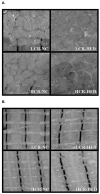Skeletal muscle mitochondrial and metabolic responses to a high-fat diet in female rats bred for high and low aerobic capacity
- PMID: 20383225
- PMCID: PMC2894534
- DOI: 10.1139/H09-139
Skeletal muscle mitochondrial and metabolic responses to a high-fat diet in female rats bred for high and low aerobic capacity
Abstract
Rats selected artificially to be low-capacity runners (LCR) possess a metabolic syndrome phenotype that is worsened by a high-fat diet (HFD), whereas rats selected to be high-capacity runners (HCR) are protected against HFD-induced obesity and insulin resistance. This study examined whether protection against, or susceptibility to, HFD-induced insulin resistance in the HCR-LCR strains is associated with contrasting metabolic adaptations in skeletal muscle. HCR and LCR rats (generation 20; n = 5-6; maximum running distance approximately 1800 m vs. approximately 350 m, respectively (p < 0.0001)) were divided into HFD (71.6% energy from fat) or normal chow (NC) (16.7% energy from fat) groups for 7 weeks (from 24 to 31 weeks of age). Skeletal muscle (red gastrocnemius) mitochondrial-fatty acid oxidation (FAO), mitochondrial-enzyme activity, mitochondrial-morphology, peroxisome proliferator-activated receptor gamma coactivator 1alpha (PGC-1alpha), and peroxisome proliferator-activated receptor delta (PPARdelta) expression and insulin sensitivity (intraperitoneal glucose tolerance tests) were measured. The HFD caused increased adiposity and reduced insulin sensitivity only in the LCR and not the HCR strain. Isolated mitochondria from the HCR skeletal muscle displayed a 2-fold-higher rate of FAO on NC, but both groups increased FAO following HFD. PGC-1alpha mRNA expression and superoxide dismutase activity were significantly reduced with the HFD in the LCR rats, but not in the HCR rats. PPARdelta expression did not differ between strains or dietary conditions. These results do not provide a clear connection between protection of insulin sensitivity and HFD-induced adaptive changes in mitochondrial function or transcriptional responses but do not dismiss the possibility that elevated mitochondrial FAO in the HCR may play a protective role.
Figures






Similar articles
-
Ovariectomized Highly Fit Rats Are Protected against Diet-Induced Insulin Resistance.Med Sci Sports Exerc. 2016 Jul;48(7):1259-69. doi: 10.1249/MSS.0000000000000898. Med Sci Sports Exerc. 2016. PMID: 26885638 Free PMC article.
-
Interactions between the consumption of a high-fat diet and fasting in the regulation of fatty acid oxidation enzyme gene expression: an evaluation of potential mechanisms.Am J Physiol Regul Integr Comp Physiol. 2011 Feb;300(2):R212-21. doi: 10.1152/ajpregu.00367.2010. Epub 2010 Nov 17. Am J Physiol Regul Integr Comp Physiol. 2011. PMID: 21084676
-
Female rats selectively bred for high intrinsic aerobic fitness are protected from ovariectomy-associated metabolic dysfunction.Am J Physiol Regul Integr Comp Physiol. 2015 Mar 15;308(6):R530-42. doi: 10.1152/ajpregu.00401.2014. Epub 2015 Jan 21. Am J Physiol Regul Integr Comp Physiol. 2015. PMID: 25608751 Free PMC article.
-
Potential regulatory role of PGC-1α within the skeletal muscle during metabolic adaptations in response to high-fat diet feeding in animal models.Pflugers Arch. 2024 Mar;476(3):283-293. doi: 10.1007/s00424-023-02890-0. Epub 2023 Dec 4. Pflugers Arch. 2024. PMID: 38044359 Free PMC article. Review.
-
Skeletal Muscle Nucleo-Mitochondrial Crosstalk in Obesity and Type 2 Diabetes.Int J Mol Sci. 2017 Apr 14;18(4):831. doi: 10.3390/ijms18040831. Int J Mol Sci. 2017. PMID: 28420087 Free PMC article. Review.
Cited by
-
Aerobic capacity and hepatic mitochondrial lipid oxidation alters susceptibility for chronic high-fat diet-induced hepatic steatosis.Am J Physiol Endocrinol Metab. 2016 Oct 1;311(4):E749-E760. doi: 10.1152/ajpendo.00178.2016. Epub 2016 Sep 6. Am J Physiol Endocrinol Metab. 2016. PMID: 27600823 Free PMC article.
-
Aerobic capacity modulates adaptive thermogenesis: Contribution of non-resting energy expenditure.Physiol Behav. 2020 Oct 15;225:113048. doi: 10.1016/j.physbeh.2020.113048. Epub 2020 Jul 3. Physiol Behav. 2020. PMID: 32628949 Free PMC article.
-
Intrinsic aerobic capacity correlates with greater inherent mitochondrial oxidative and H2O2 emission capacities without major shifts in myosin heavy chain isoform.J Appl Physiol (1985). 2012 Nov;113(10):1624-34. doi: 10.1152/japplphysiol.01475.2011. Epub 2012 Sep 20. J Appl Physiol (1985). 2012. PMID: 22995392 Free PMC article.
-
Differential weight loss with intermittent fasting or daily calorie restriction in low- and high-fitness phenotypes.Exp Physiol. 2021 Aug;106(8):1731-1742. doi: 10.1113/EP089434. Epub 2021 Jul 7. Exp Physiol. 2021. PMID: 34086376 Free PMC article.
-
Increased aerobic capacity reduces susceptibility to acute high-fat diet-induced weight gain.Obesity (Silver Spring). 2016 Sep;24(9):1929-37. doi: 10.1002/oby.21564. Epub 2016 Jul 28. Obesity (Silver Spring). 2016. PMID: 27465260 Free PMC article.
References
-
- Abdul-Ghani MA, Jani R, Chavez A, Molina-Carrion M, Tripathy D, Defronzo RA. Mitochondrial reactive oxygen species generation in obese non-diabetic and type 2 diabetic participants. Diabetologia. 2009;52:574–82. - PubMed
Publication types
MeSH terms
Substances
Grants and funding
LinkOut - more resources
Full Text Sources
Medical

